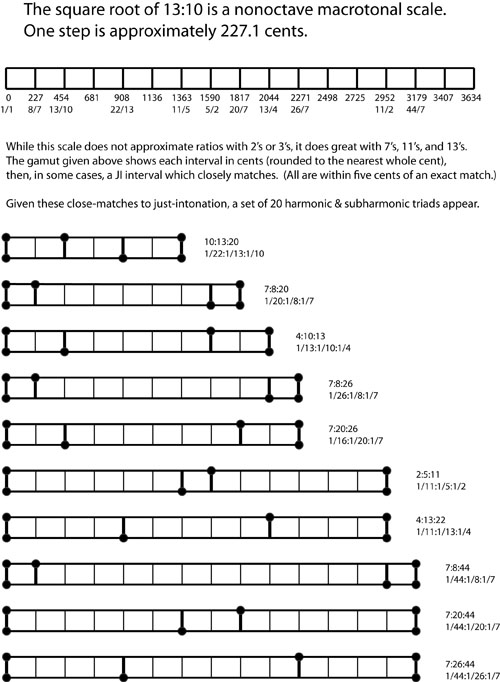2ed13/10
| ← 1ed13/10 | 2ed13/10 | 3ed13/10 → |
(convergent)
2 equal divisions of 13/10, when viewed from a regular temperament perspective, is a nonoctave tuning system created by diving the interval of 13/10 into two steps of about 227.1 cents each. It is equivalent to about 5.284edo.
Theory
13:10, as a frequency ratio, measures approximately 454.2 cents. It lies in the extremely xenharmonic and ambiguous territory between the perceptual category of a "third" and that of a "fourth" (see interseptimal). It appears in the overtone series between the tenth and thirteen overtones. The "square root of 13:10", then, means an interval which logarithmically bisects 13:10. It's an irrational number which measures, in cents, about 227.1.
"The square root of 13:10" can also refer to the scale that is produced by repeatedly stacking the interval "the square root of 13:10". It is an EDONOI, or "equal division of a nonoctave interval," and as such, it does not contain a perfect octave (2:1). It is also macrotonal, since the smallest step, at 227.1 cents, is larger than a semitone.
In terms of equal divisions of the octave, it fits between 5edo and 6edo. Melodically, it can sound somewhat "pentatonic," but harmonically it is very different.
Harmonic content
| Harmonic | 2 | 3 | 4 | 5 | 6 | 7 | 8 | 9 | 10 | 11 | 12 | |
|---|---|---|---|---|---|---|---|---|---|---|---|---|
| Error | Absolute (¢) | -64.5 | -85.1 | +98.2 | -61.0 | +77.5 | +37.8 | +33.7 | +56.9 | +101.6 | -63.4 | +13.1 |
| Relative (%) | -28.4 | -37.5 | +43.2 | -26.9 | +34.1 | +16.6 | +14.8 | +25.1 | +44.7 | -27.9 | +5.8 | |
| Steps (reduced) |
5 (1) |
8 (0) |
11 (1) |
12 (0) |
14 (0) |
15 (1) |
16 (0) |
17 (1) |
18 (0) |
18 (0) |
19 (1) | |
Sqrt 13:10 (the scale) contains no octaves, and also no close approximation of the third harmonic (the perfect fifth). However, it comes very close to certain just intervals involving the numbers 5, 7, 11 and 13: in particular: 8/7, 13/10, 22/13, 11/5, 5/2, 20/7, 13/4, 26/7, 11/2, and 44/7. These near-just intervals can be combined so as to make available a set of 20 harmonic and subharmonic chords.
From (8/7)^2 ~ 13/10, we can conclude 640/637 is tempered out; from 22/13 ~ (13/10)^2 that 2200/2197 is tempered out; and from 5/2 ~ (8/7)*(11/5) 176/175 is tempered out. The other approximations follow from these, suggesting either the rank three temperament tempering them out, or the rank two no-threes 2.5.7.11.13 subgroup temperament. That has a mapping [<1 1 3 1 2|, <0 7 -1 13 9|], and could be called the no-threes 16&21 temperament. It can be extended to the full 13-limit as 21&37.
Music
Scala file
! sqrt13over10.scl The square root of 13:10 nonoctave temperament. 2 ! 227.106973952238 13/10
